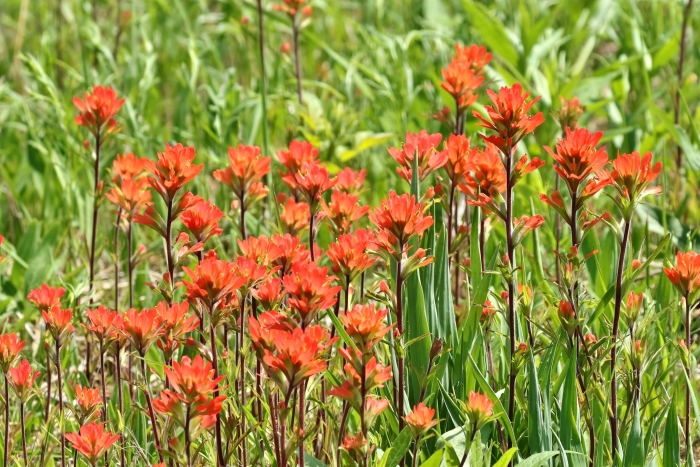Scarlet Indian Paintbrush
(Castilleja coccinea)
Scarlet Indian Paintbrush (Castilleja coccinea)
/
/

© Thibaud Aronson
CC BY-SA 4.0
Image By:
© Thibaud Aronson
Recorded By:
Copyright:
CC BY-SA 4.0
Copyright Notice:
Photo by: © Thibaud Aronson | License Type: CC BY-SA 4.0 | License URL: http://creativecommons.org/licenses/by-sa/4.0/ | Uploader: thibaudaronson | Publisher: iNaturalist |
























Estimated Native Range
Summary
Castilleja coccinea, commonly known as Scarlet Indian Paintbrush, is a biennial herb native to prairies, rocky glades, moist meadows, open woodlands, and along streams in central and eastern North America. It typically grows to a height of 12 to 24 inches (30-60 cm). The plant is notable for its vibrant red bracts that surround the inconspicuous yellow to greenish flowers, which bloom from April to June. The bracts are often mistaken for petals and are the most showy part of the plant, providing a striking display in spring and early summer. The actual flowers are tubular and can be pollinated by the ruby-throated hummingbird, which is attracted to the red coloration.
Scarlet Indian Paintbrush is valued for its unique appearance and is often used in wildflower gardens, native plant landscapes, and restoration projects. It is adapted to a range of soil types but prefers well-drained soils and can tolerate both full sun and partial shade. While it can be grown from seed, it is important to note that as a hemiparasitic plant, it benefits from growing in proximity to certain grasses or other host plants, which it parasitizes to obtain nutrients. This relationship can be beneficial in garden settings where it can help control the growth of more aggressive plants. However, care should be taken not to plant it near sensitive species that could be harmed by its parasitic nature. There are no major disease problems associated with this plant, but it may be difficult to establish and maintain in a garden setting due to its parasitic nature and biennial life cycle.CC BY-SA 4.0
Scarlet Indian Paintbrush is valued for its unique appearance and is often used in wildflower gardens, native plant landscapes, and restoration projects. It is adapted to a range of soil types but prefers well-drained soils and can tolerate both full sun and partial shade. While it can be grown from seed, it is important to note that as a hemiparasitic plant, it benefits from growing in proximity to certain grasses or other host plants, which it parasitizes to obtain nutrients. This relationship can be beneficial in garden settings where it can help control the growth of more aggressive plants. However, care should be taken not to plant it near sensitive species that could be harmed by its parasitic nature. There are no major disease problems associated with this plant, but it may be difficult to establish and maintain in a garden setting due to its parasitic nature and biennial life cycle.CC BY-SA 4.0
Plant Description
- Plant Type: Herb
- Height: 0.75-2 feet
- Width: 1-1.5 feet
- Growth Rate: Moderate, Rapid
- Flower Color: Red, Orange, Yellow, White, Pink
- Flowering Season: Spring, Summer
- Leaf Retention: Deciduous
Growth Requirements
- Sun: Full Sun, Part Shade
- Water: Medium
- Drainage: Fast, Medium
Common Uses
Butterfly Garden, Deer Resistant, Drought Tolerant, Erosion Control, Low Maintenance, Rabbit Resistant
Natural Habitat
Prairies, rocky glades, moist meadows, open woodlands, and along streams in central and eastern North America
Other Names
Common Names: Prairie Fire, Scarlet Indian Paintbrush, Scarlet Paintbrush, Painted-Cup Paintbrush, Scarlet Painted-Cup, Eastern Paintbrush, Red Paintbrush
Scientific Names: , Castilleja coccinea, Bartsia coccinea, Bartsia coccinea var. pallens, Castilleja coccinea f. alba, Castilleja coccinea f. coccinea, Castilleja coccinea f. lutescens, Castilleja coccinea f. pallens, Castilleja ludoviciana, Euchroma coccinea
GBIF Accepted Name: